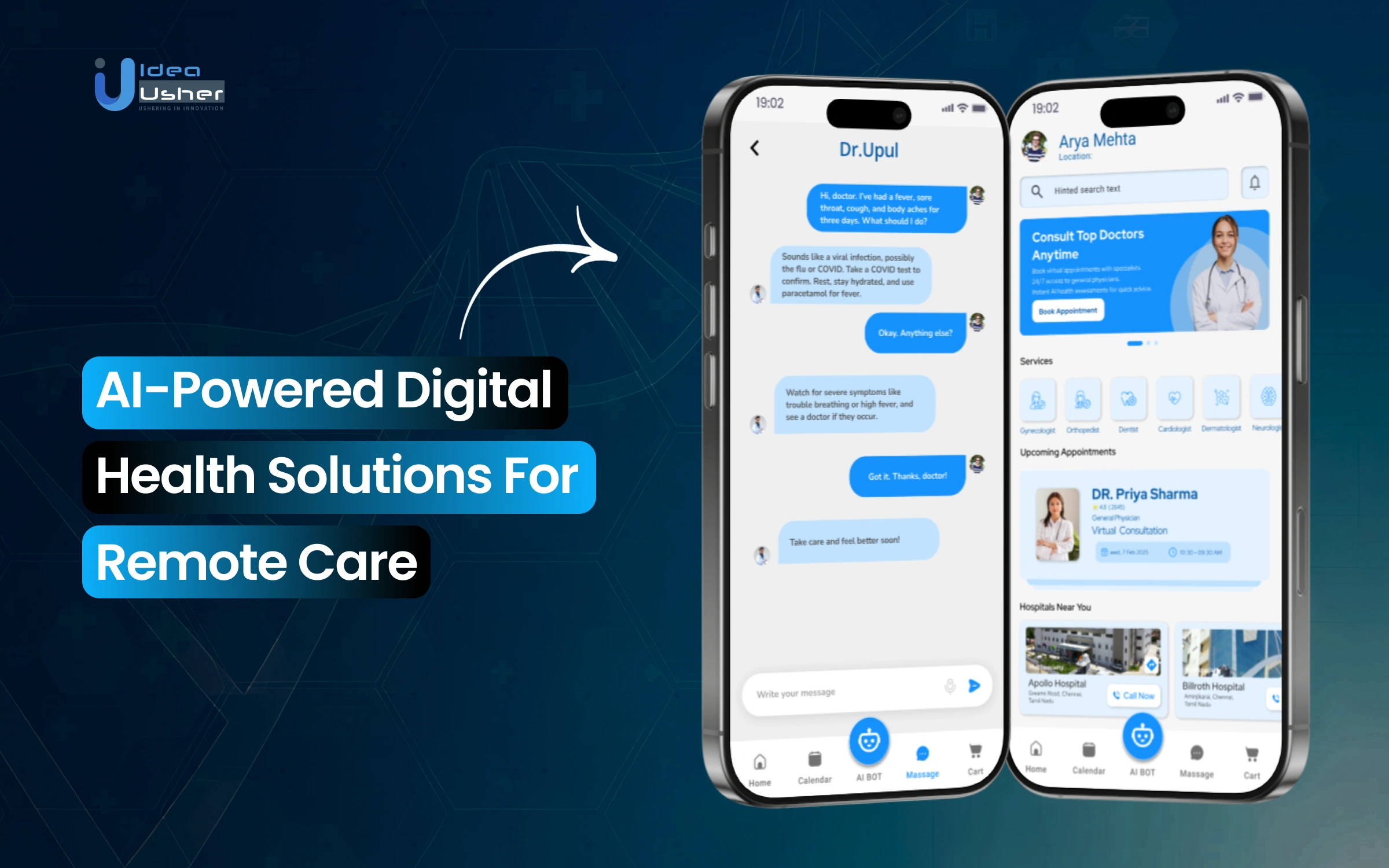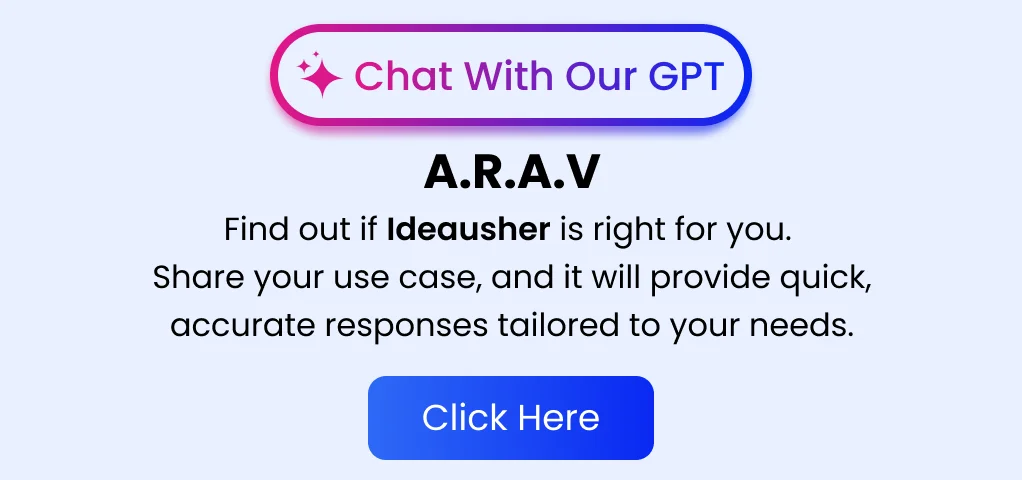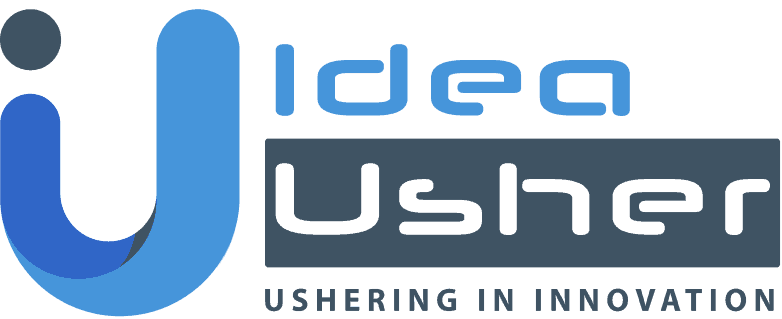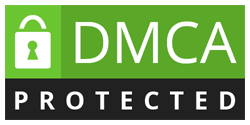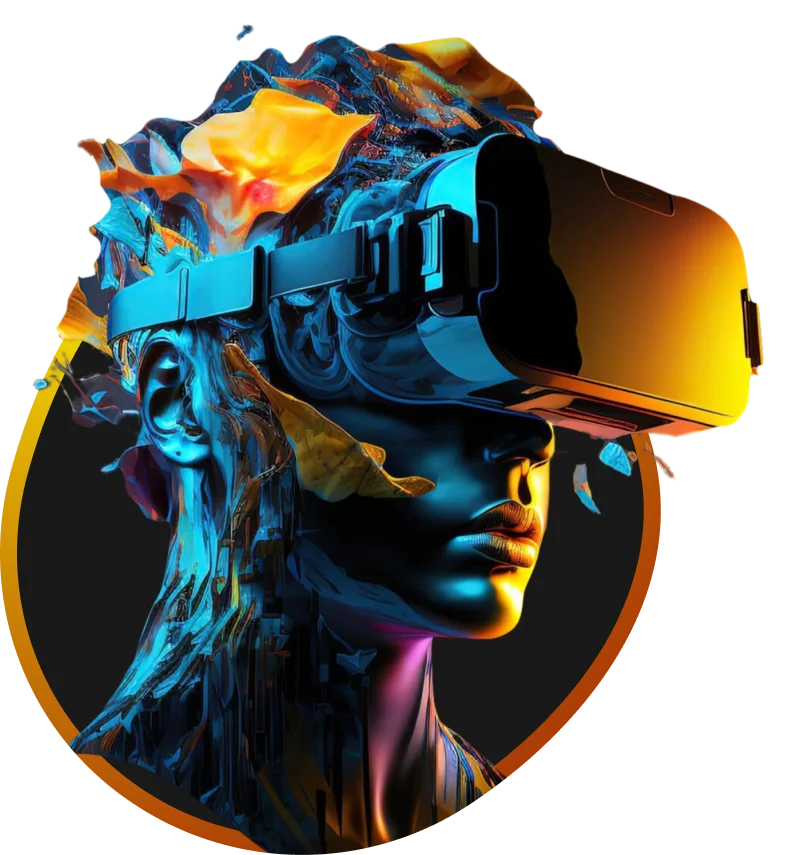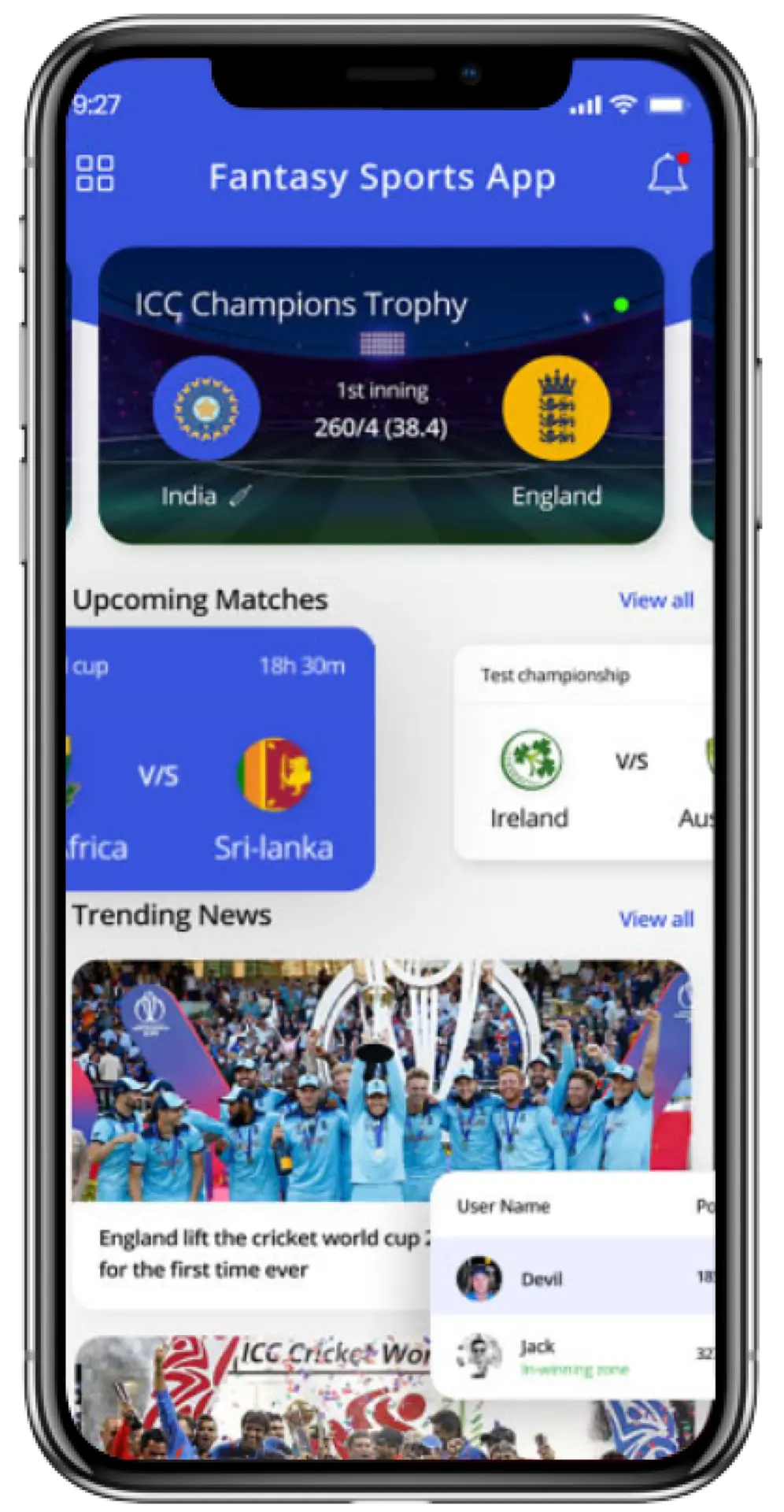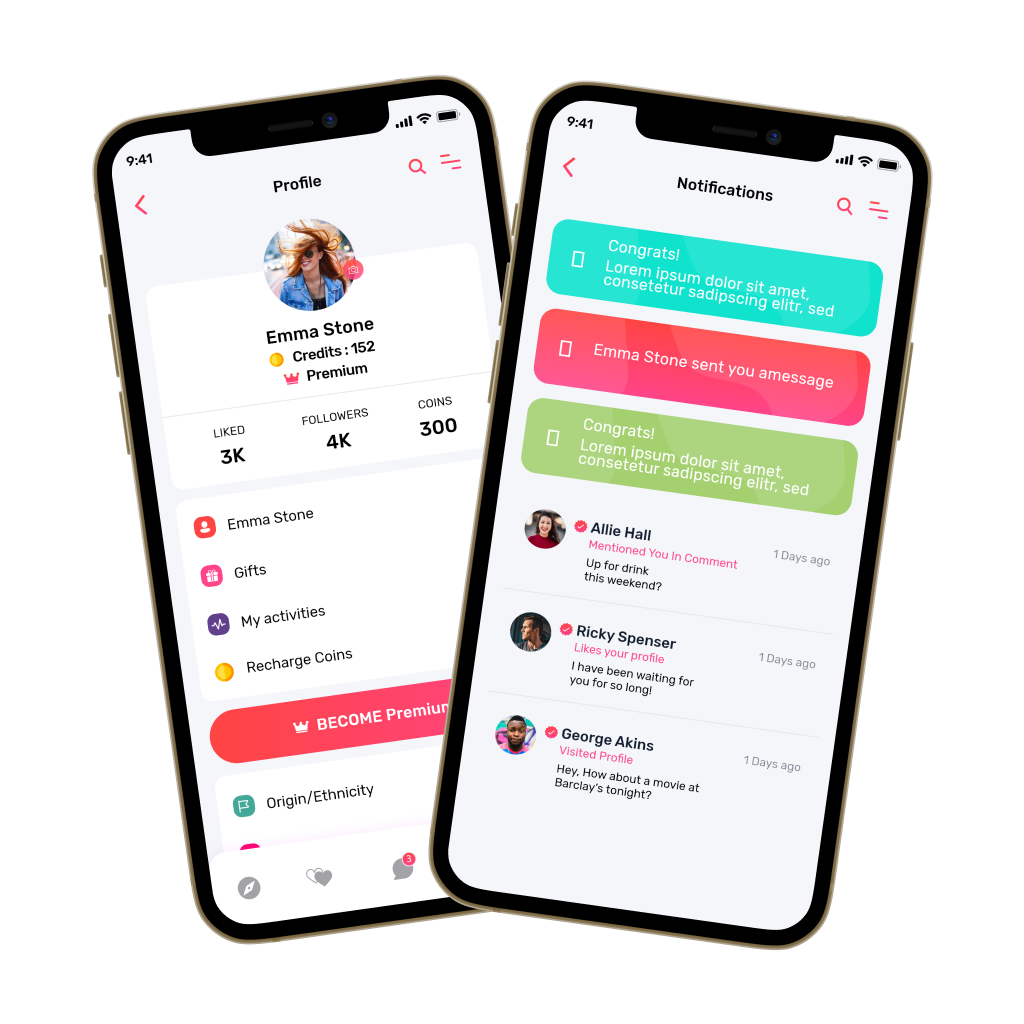Access to healthcare shouldn’t depend on location, yet for many people, distance and availability still limit how and when they receive medical support. The growing demand for continuous, accessible care has pushed innovation toward smarter solutions. An AI health app for remote care bridges this gap by helping patients stay connected with providers through real-time insights, personalized recommendations, and continuous monitoring.
AI-driven systems are now capable of monitoring vitals, predicting health risks, and assisting doctors in making data-backed decisions, transforming how remote care operates. These innovations combine machine learning, predictive analytics, and virtual communication tools to create experiences that feel both personal and proactive.
In this blog, we’ll look at how AI-powered digital health solutions are changing remote care. We’ll discuss their main features, the technologies behind them, and the strategies that help keep them secure and effective. IdeaUsher combines AI innovation with healthcare knowledge to create solutions that enhance patient outcomes, ensure compliance, and provide long-term operational value for organizations.
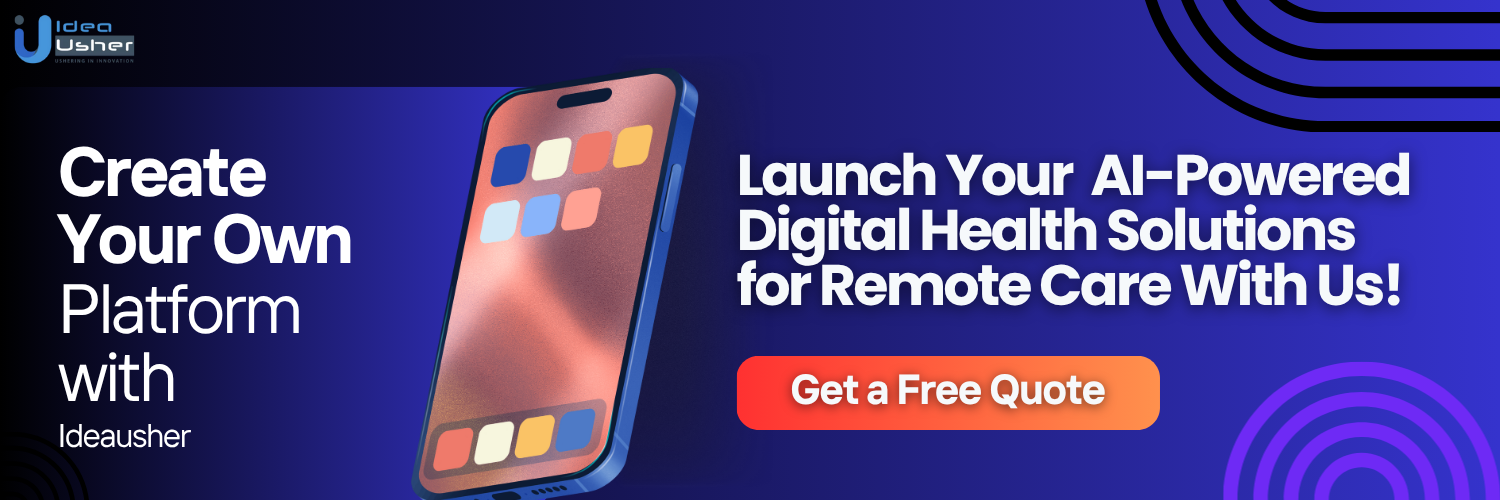
What is an AI-Powered Remote Health Platform?
An AI-powered digital health solution for remote care is an advanced healthcare platform that uses artificial intelligence to deliver medical services, monitor health, and provide personalized care remotely. These solutions combine AI-driven analytics, telehealth tools, and real-time monitoring to create an intelligent ecosystem that bridges the gap between patients and providers without the need for physical visits.
The platform empowers providers to give timely, data-driven care and enable patients to receive personalized treatment and continuous monitoring from anywhere.
- Enhancing Accessibility: Allowing patients to access healthcare services regardless of location or time.
- Reducing Clinical Burden: Automating repetitive tasks such as documentation, diagnosis suggestions, and monitoring.
- Improving Patient Outcomes: Using AI insights to deliver personalized care and early intervention.
- Optimizing Operational Efficiency: Reducing wait times, improving resource utilization, and lowering healthcare costs.
How AI-Powered Digital Health Solution for Remote Care Works?
An AI-powered remote care platform brings together data, smart technology, and communication to make virtual healthcare smooth and easy. Here’s how the process usually works:
1. Patient Onboarding & Profile Setup
Users sign up by entering their personal, medical, and lifestyle information, or by connecting their electronic health records. The AI then creates a health profile that gets smarter with each interaction, helping to make care recommendations more personal over time.
2. AI-Driven Symptom Assessment
Patients share their symptoms using chat or voice. The AI, using natural language processing, reviews what they say, checks it against medical data, and offers an initial suggestion like ‘consult a doctor,’ ‘self-care advice,’ or ‘urgent care needed.’
3. Real-Time Teleconsultation
If a consultation is needed, the platform sets up a secure video or chat session with a licensed clinician. During the visit, the AI helps by showing important medical history, creating visit notes, and suggesting possible diagnoses or next steps.
4. Health Data Monitoring & Analysis
Wearables and smart devices, such as smartwatches or blood pressure monitors, send health data to the platform all the time. The AI watches these numbers in real time, spots any unusual changes, and lets the provider or patient know if something needs attention.
5. Personalized Treatment & Recommendations
After the consultation and AI review, the platform creates a care plan tailored to the user. This might include reminders for medication, tips for healthy living, or digital tools like guided exercises. As the AI learns more, the advice keeps getting better.
6. Continuous Feedback Loop & Predictive Analytics
The AI gathers feedback on treatment outcomes, adherence, and interactions. Over time, this data boosts predictive accuracy, allowing early detection of health issues and enabling providers to deliver proactive care.
Why Anyone Should Invest in AI-Powered Digital Health Platforms?
The global remote healthcare market was valued at approximately USD 69 billion in 2024 and is projected to reach over USD 219 billion by 2030, growing at a compound annual growth rate (CAGR) of 21.3% from 2025 to 2030. This rapid expansion underscores the increasing demand for innovative solutions that enhance healthcare delivery, particularly in remote settings.

Heidi Health raised $65 million in a Series B round, bringing its total funding to $97 million. The company offers AI-driven clinical documentation tools and has a global user base across 116 countries.
Midi Health secured $50 million in a Series C funding round, specializing in virtual care for perimenopause and menopause. The company now serves around 20,000 patients weekly and has reached a $150 million annual revenue run rate.
Zingage obtained $12.5 million in seed funding to develop AI-powered solutions for home healthcare delivery, including tools for caregiver engagement and operational automation.
hellocare.ai acquired $47 million in funding to enhance its AI-enabled virtual care delivery solutions for smart hospital rooms.
Investing in AI-powered digital health platforms presents opportunities to tap into the growing remote healthcare market. The 2024 funding surge shows investor confidence in AI solutions to improve patient outcomes, efficiency, and healthcare access. Early investment could yield substantial returns and advance global healthcare delivery.

How AI Is Revolutionizing Remote Care Delivery?
Artificial intelligence is reshaping how patients access, receive, and manage healthcare remotely. By combining predictive analytics, natural language processing, and automation, AI makes virtual care faster, more precise, and deeply personalized. Below are the key AI use cases driving this transformation:
1. Intelligent Symptom Assessment & Triage
AI chatbots and virtual assistants use natural language processing and medical data to quickly assess symptoms. They guide patients to the right care, help avoid unnecessary doctor visits, and offer timely support for self-care, virtual consultations, or emergencies.
Example: Babylon Health and Buoy Health use AI symptom checkers to assess patients and suggest next steps, reducing unnecessary visits.
2. Personalized Care Plans & Recommendations
Machine learning algorithms analyze patient history, vitals, and behavior to generate tailored care plans. These systems adapt over time, suggesting diet, medication, or lifestyle changes based on continuous feedback and health progress.
Example: Ada Health uses AI to personalize care insights, while Lifelink Systems provides conversational health interfaces that adapt to patient progress and medical data.
3. Predictive Health Monitoring
AI models interpret data from wearables and remote monitoring devices to predict potential complications before they escalate. This enables early detection of issues like cardiac irregularities or diabetic spikes, helping clinicians intervene proactively.
Example: Current Health and Biofourmis deploy AI-based analytics to detect early signs of deterioration in remote patients, allowing clinicians to intervene before crises occur.
4. Automated Clinical Documentation
Virtual scribe systems automatically record, summarize and structure consultation data. This removes the manual burden on clinicians, improves accuracy in medical records, and allows doctors to focus more on patient engagement.
Example: Suki AI and Nuance DAX automatically document patient interactions, saving physicians hours and improving EHR accuracy.
5. Virtual Mental Health Support
AI-driven therapy bots use sentiment analysis and conversational cues to detect emotional distress and offer immediate coping support. They can also escalate critical cases to licensed professionals, ensuring safety and continuity of care.
Example: Wysa and Woebot offer AI-driven CBT chatbots that help users manage anxiety, depression, and stress while ensuring clinical-grade data privacy.
6. Medication Adherence & Refill Automation
AI reminders, smart pill dispensers, and predictive refill systems monitor prescription schedules and alert patients or pharmacies when doses are missed or supplies run low, improving adherence and treatment outcomes.
Example: Medisafe and Pillo Health use AI to track medication adherence, send alerts for missed doses, and automatically coordinate refills with pharmacies.
7. Fraud Detection & Data Security
AI models analyze behavioral patterns to identify anomalies in telehealth transactions and prevent insurance or identity fraud. They also enhance cybersecurity through continuous risk monitoring and anomaly detection.
Example: Darktrace uses AI anomaly detection to secure telehealth, and Clearsense employs predictive analytics to spot fraud and data breaches in healthcare networks.
8. Virtual Diagnostics & Imaging Analysis
Through computer vision and deep learning, AI assists clinicians in interpreting X-rays, CT scans, or dermatological images remotely. This accelerates diagnosis, enhances precision, and makes expert-level insights accessible even in underserved areas.
Example: Aidoc and Zebra Medical Vision use deep learning to analyze medical images, helping radiologists detect critical findings and speed up diagnosis.
Key Features of an AI-Powered Digital Health Solution for Remote Care
AI-powered digital health solutions transform remote care with smarter, personalized, and efficient healthcare. They use real-time data, predictive insights, and automation to improve patient monitoring and clinical decisions beyond traditional settings.

1. AI-Based Symptom Checker and Virtual Triage
An integrated AI system allows patients to input their symptoms, which are then analyzed using medical algorithms to suggest possible conditions and care routes. It helps determine whether self-care, teleconsultation, or emergency attention is needed, reducing unnecessary appointments and optimizing clinical workload.
2. Predictive Analytics for Health Risk Detection
AI models continuously evaluate patient data from wearables, medical records, and past consultations to predict potential health risks. This feature enables early detection of chronic disease patterns, helping providers take preventive measures before conditions escalate.
3. Smart Clinical Decision Support System (CDSS)
The CDSS uses AI to assist clinicians by offering data-driven treatment options, identifying medication conflicts, and recommending diagnostic tests. It strengthens decision-making, reduces human error, and ensures evidence-based care delivery.
4. Natural Language Processing (NLP) for Documentation
AI-powered NLP tools automatically capture and summarize doctor-patient conversations, converting them into structured medical notes. This minimizes manual data entry, enhances accuracy, and allows healthcare providers to focus more on patient interaction rather than paperwork.
5. Personalized Care Plans
AI customizes care pathways based on each patient’s health profile, treatment response, and behavioral data. These adaptive plans evolve with patient progress, ensuring more targeted interventions and higher treatment adherence.
6. Virtual Mental Health Assistant
AI-driven chatbots and virtual counselors offer 24/7 emotional and psychological support. They use conversational intelligence to detect distress patterns and provide guidance or escalate cases to human therapists when needed, ensuring timely mental health assistance.
7. Automated Remote Monitoring
IoT-integrated AI systems track vital signs like heart rate, blood pressure, and oxygen levels in real-time. The data is continuously analyzed to identify irregularities, automatically alerting healthcare teams in case of emergencies or deviations from normal health metrics.
8. Secure Data Management and Compliance
AI strengthens platform security by detecting anomalies, monitoring user access patterns, and encrypting sensitive data. Compliance with healthcare regulations such as HIPAA or GDPR is maintained through automated audits and real-time data protection measures.
9. Automated Follow-Up and Engagement Tools
AI ensures consistent post-care engagement by sending automated follow-ups, medication reminders, and progress surveys. These interactions not only improve patient satisfaction but also help clinicians track treatment effectiveness remotely.
10. Multilingual and Accessibility Support
AI-powered voice recognition, translation, and text-to-speech tools make digital healthcare more inclusive. This ensures that patients from diverse linguistic backgrounds or with disabilities can easily access, understand, and engage with remote healthcare services.

Development Process of AI-Powered Digital Health Solution for Remote Care
Creating an AI-driven digital health tool for remote care needs a multidisciplinary approach with healthcare expertise, AI engineering, and user-focused design. Our process ensures accuracy, compliance, and ongoing improvement for reliable remote healthcare solutions.

1. Consultation
We begin by understanding the target audience including patients and healthcare providers, defining their pain points, and outlining functional goals like AI-driven triage and teleconsultation, while ensuring strict adherence to HIPAA, GDPR, and local healthcare regulations.
2. UI/UX Design
Our designers create intuitive, accessible interfaces for patients, doctors, and administrators, embedding AI personalization and building trust through thoughtful visual design while mapping smooth user journeys that enhance usability and foster long-term engagement.
3. AI Model Development and Training
Our AI engineers develop and train custom algorithms for symptom analysis, predictive diagnosis, and recommendations using real healthcare datasets, employing frameworks like TensorFlow and PyTorch to ensure clinical accuracy, scalability, and reliability in decision-making.
4. Backend Development
Our developers build a secure, scalable backend with microservices architecture, enabling robust EHR integration, authentication, and cloud storage, ensuring the platform delivers high performance, real-time AI processing, and efficient healthcare data management.
5. Real-Time Health Data Integration
We will use secure APIs from trusted health apps that collect wearable, IoT, and health system data, enabling continuous monitoring of vital signs such as heart rate, glucose, and oxygen saturation for real-time AI-driven insights and proactive care.
6. Testing
Our QA team conducts functional, usability, and performance testing, validating AI models against clinical data while incorporating healthcare professional feedback to ensure diagnostic accuracy, patient safety, and unbiased outcomes.
7. Security Implementation
We implement advanced cybersecurity measures such as encryption, biometric authentication, and access controls, followed by external compliance audits to guarantee our remote health solution meets all medical data safety and regulatory standards.
8. Deployment
We deploy the platform on secure cloud infrastructures such as AWS, Azure, or Google Cloud, configuring CI/CD pipelines to enable continuous updates, seamless scalability, and 24/7 reliability for healthcare providers and patients.
9. Continuous Monitoring & AI Optimization
We continuously monitor platform performance, AI accuracy, and user engagement, retraining AI models with new data to improve predictions, adapt to emerging health trends, and maintain an efficient and reliable remote care system.
10. Feedback Loop and Feature Enhancement
We collect and analyze feedback from patients, doctors, and institutions, using insights to enhance features such as adaptive triage, multilingual support, and emotional analytics to keep the AI-powered digital health platform innovative and patient-focused.
Cost to Build an AI-Powered Remote Health Solution
The cost of building an AI-powered remote health solution can vary widely depending on features, complexity, and technology stack. Understanding these factors is crucial for budgeting and ensuring a scalable, efficient digital healthcare platform.
| Development Phase | Description | Estimated Cost |
| 1. Consultation | Defines business goals, technical scope, and core AI-driven features for remote healthcare delivery. | $4,000 – $7,000 |
| 2. UI/UX Design | Designs an intuitive and accessible interface for both patients and healthcare providers. | $6,000 – $10,000 |
| 3. AI Model Development and Training | Builds and trains AI models for diagnostics, predictions, and personalized health insights. | $15,000 – $35,000 |
| 4. Backend Development | Develops APIs, databases, and core logic to enable secure data processing and communication. | $10,000 – $18,000 |
| 5. Real-Time Health Data Integration | Integrates wearables, IoT sensors, and EHR systems for live health data monitoring. | $8,000 – $15,000 |
| 6. Testing | Conducts performance, security, and usability testing to ensure stable operations. | $6,000 – $10,000 |
| 7. Security Implementation | Adds HIPAA-compliant encryption, secure access control, and threat monitoring. | $5,000 – $9,000 |
| 8. Deployment | Sets up production environments and cloud infrastructure for smooth launch. | $4,000 – $8,000 |
| 9. Continuous Monitoring & AI Optimization | Tracks AI performance, enhances model accuracy, and ensures system stability. | $6,000 – $12,000 |
| 10. Feature Enhancement | Uses user feedback to improve features and refine AI capabilities post-launch. | $6,000 – $10,000 |
Total Estimated Cost: $65,000 – $130,000
Note: This is an estimated cost breakdown to help understand the investment for developing an AI-powered remote health platform. Consult with IdeaUsher for customized guidance and expert development support.
Recommended Tech Stack for AI-Powered Remote Health Solutions
Choosing the right technology stack is key for a secure, scalable, efficient AI-driven remote health solution. These tools and frameworks support frontend and backend development, real-time communication, AI integration, and compliance.
1. Frontend
These frameworks are used to create the user interface of the app. React and Angular are ideal for web applications, while Flutter allows cross-platform mobile development for both iOS and Android, ensuring a smooth, responsive user experience.
2. Backend
The backend handles server logic, APIs, database interactions, and user authentication. Node.js is efficient for real-time applications, and Django provides a robust, secure framework for handling complex healthcare workflows.
3. AI/ML Frameworks
These frameworks power AI features such as symptom analysis, predictive health recommendations, and natural language understanding. TensorFlow and PyTorch allow custom AI model development, while OpenAI API enables integration of advanced NLP capabilities.
4. Video SDKs
These tools enable real-time video and voice communication for virtual consultations. WebRTC is open-source and lightweight, Agora provides scalable low-latency video, and Twilio ensures secure and reliable telemedicine calls.
5. Database
Databases store user data, health records, and AI-generated insights. PostgreSQL is a relational database suitable for structured healthcare data, while MongoDB handles unstructured or semi-structured data efficiently.
6. Cloud & Security
Cloud platforms provide scalable infrastructure and secure storage. They support HIPAA-compliant environments to ensure patient data privacy, regulatory compliance, and high availability for healthcare applications.
Challenges & How to Overcome Them?
Creating AI-driven digital health solutions for remote care requires navigating complex technology, sensitive patient data, and regulatory hurdles to ensure security, scalability, and user-friendliness. Below are the key challenges and how we tackle them.
1. Ensuring Data Privacy & Compliance
Challenge: Healthcare data is highly sensitive, and non-compliance with HIPAA, GDPR, or local regulations can result in legal penalties.
Solution: We implement end-to-end encryption, role-based access control, and regular compliance audits. Our team continuously updates policies and aligns all processes with evolving healthcare regulations to ensure full compliance.
2. Integrating Heterogeneous Systems
Challenge: Remote care platforms must integrate with EHRs, wearables, and hospital tools, which can cause data incompatibility and delays.
Solution: We use standard APIs and interoperability frameworks like HL7/FHIR. Our developers build scalable middleware that enables smooth integration across systems and ensures compatibility with future expansions.
3. Maintaining AI Model Accuracy
Challenge: AI predictions may degrade without fresh data, risking patient safety and platform reliability.
Solution: We create continuous learning pipelines and regularly retrain models with anonymized real-world data. Our team validates AI outputs with clinical experts to maintain high accuracy and reliability.
4. Scalability & Infrastructure Challenges
Challenge: Growing user bases and data volume can strain the system without a robust architecture.
Solution: We deploy cloud-native infrastructure on AWS, Azure, or GCP, implement microservices, and enable auto-scaling. This ensures the platform handles high demand efficiently without performance drops.
5. Managing Patient Engagement & Trust
Challenge: Users may hesitate to trust AI recommendations or use the platform consistently.
Solution: We design transparent AI workflows, integrate patient education tools, and build intuitive interfaces. These strategies maintain engagement and foster trust in the platform’s recommendations.

5 Real-World AI-Powered Digital Health Solutions Transforming Remote Care
AI is changing digital healthcare by making remote care and patient monitoring more effective. With machine learning, wearables, and virtual consultations, these tools offer quicker diagnoses, proactive support, and improved results, all from the comfort of home.
1. Cedars-Sinai Connect
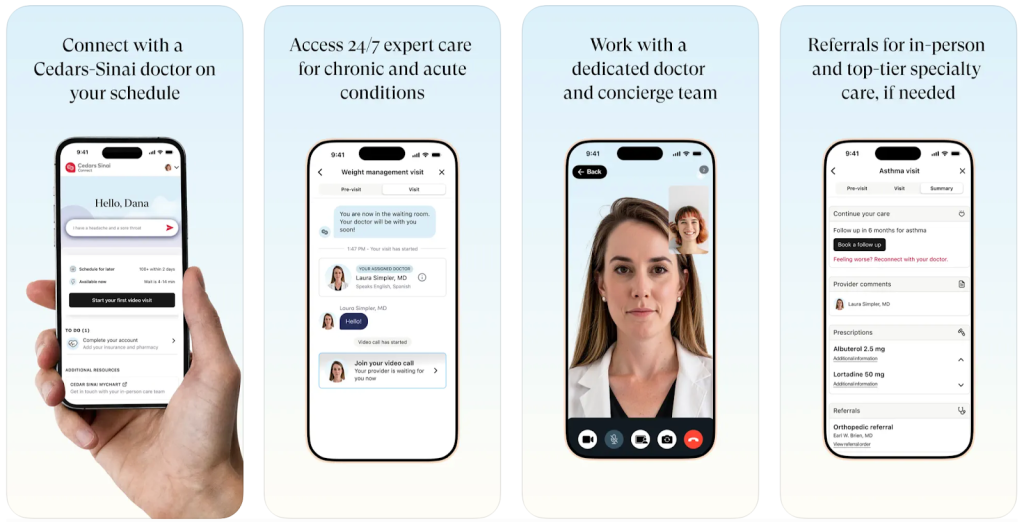
Cedars-Sinai partnered with K Health to create CS Connect, an AI-driven virtual care platform. It automates symptom intake, generates treatment recommendations, and supports clinicians. Over 42,000 patients have used it, with AI treatment plans rated optimal in 77% of cases.
2. Lark Health
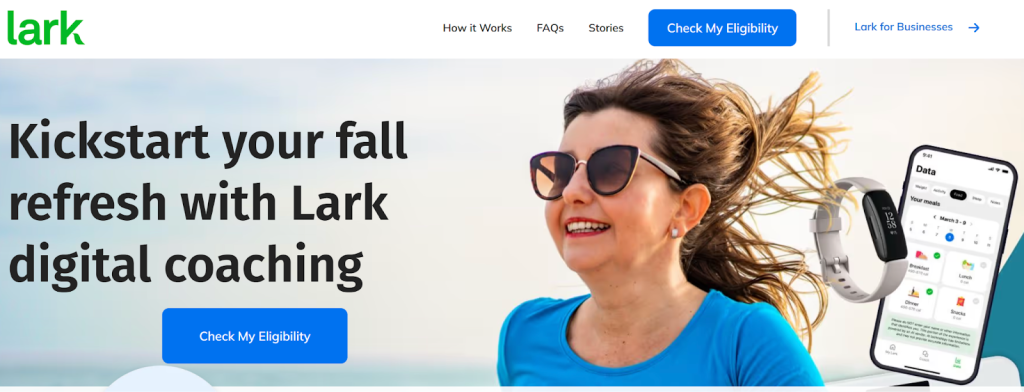
Lark Health provides 24/7 AI coaching for chronic conditions like diabetes, hypertension, and obesity. It syncs with connected health devices, analyzes patient data, and delivers personalized feedback. Serving 1.5 million users, its CDC-recognized Diabetes Prevention Program proves measurable behavioral and clinical success.
3. Biofourmis
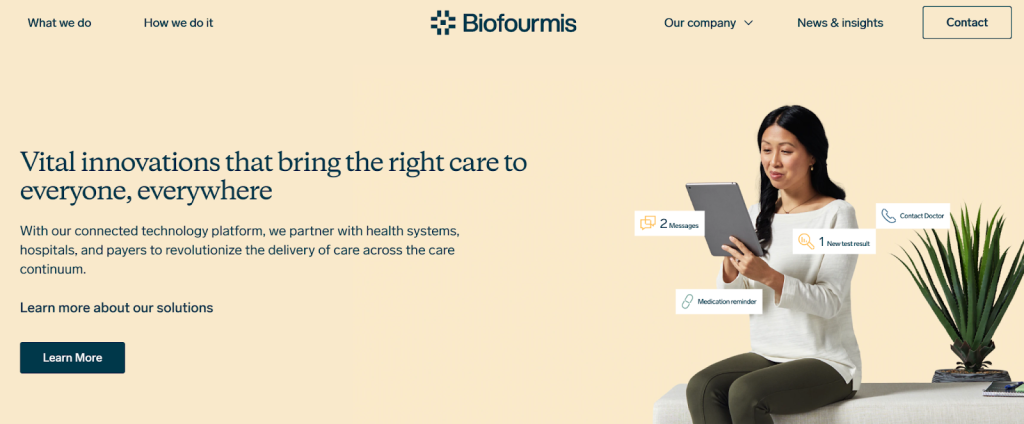
Biofourmis specializes in AI-powered remote patient monitoring using wearables and sensors. Its algorithms predict health declines by analyzing physiological trends in real time. The platform reduces hospital readmissions by up to 27%, enabling a proactive, data-driven model of chronic and post-acute care.
4. K Health
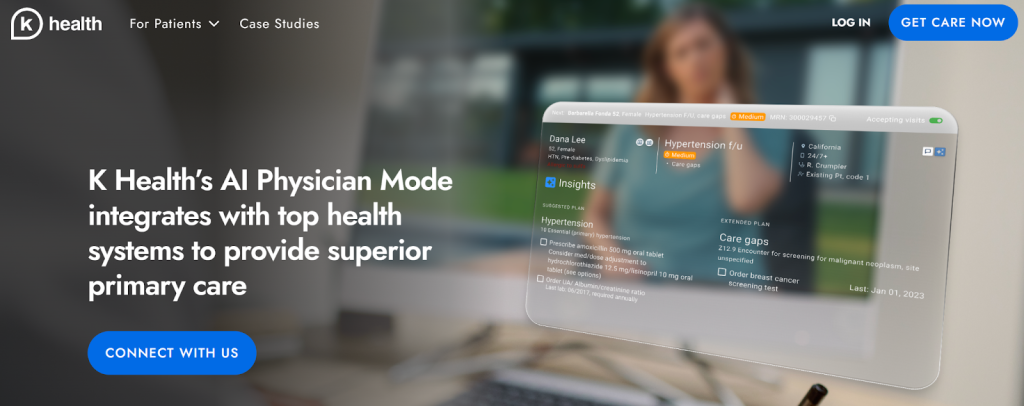
K Health is a primary care platform that uses AI to provide virtual healthcare through its mobile app. The app includes a chat-based symptom checker to suggest possible diagnoses, supports online doctor visits, and works with health systems and insurers to deliver care.
5. Earkick
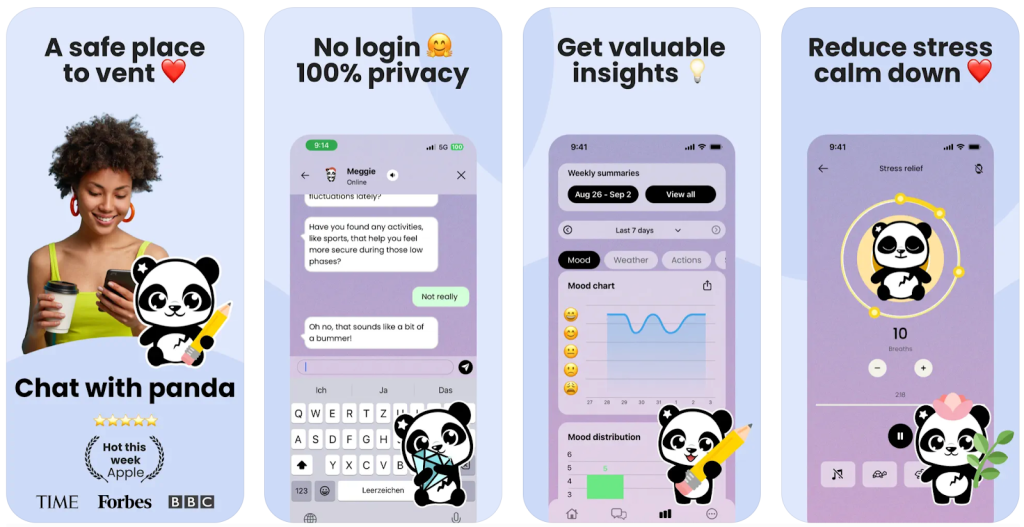
Earkick delivers AI-based mental health support through real-time biomarker tracking and language analysis. Its LLM-powered companion offers adaptive emotional insights and coping strategies. By providing continuous, private support, it bridges mental health gaps for users without immediate access to therapists.
Conclusion
AI digital health solutions for remote care are transforming how healthcare is delivered, making it more accessible, personalized, and efficient. By integrating intelligent monitoring, virtual consultations, and predictive analytics, these platforms enhance patient outcomes and streamline clinical workflows. Healthcare providers can respond faster to patient needs, reduce operational strain, and expand care to underserved regions. Implementing an AI digital health solution for remote care not only improves service quality but also positions organizations to lead in the evolving digital healthcare landscape.
Why Choose IdeaUsher for Your AI Digital Health Solution for Remote Care?
At IdeaUsher, we help healthcare businesses design AI-powered remote care solutions that bring intelligence, automation, and personalized support into digital healthcare ecosystems. We focus on delivering secure, data-driven, and patient-centered platforms ready for scale.
Why Work with Us?
- AI and Healthcare Expertise: We build AI models that analyze patient data and support clinical decision-making in real time
- Custom Remote Care Solutions: From patient monitoring to virtual consultations, we deliver tailored platforms that fit your use case.
- Regulatory Compliance: Our solutions adhere to healthcare data protection standards like HIPAA, ensuring complete privacy and security.
- Proven Track Record: We’ve helped healthcare startups and enterprises transform remote care delivery through intelligent automation.
Browse our portfolio to see how we’ve empowered healthcare providers with technology-driven digital transformation.
Connect with us today to develop your AI-powered digital health solution for remote care that enhances outcomes and drives innovation.
Work with Ex-MAANG developers to build next-gen apps schedule your consultation now
FAQs
An AI digital health solution for remote care uses artificial intelligence to deliver virtual consultations, monitor patient health, and provide predictive insights. It helps healthcare providers offer timely, personalized, and efficient care remotely.
AI can analyze patient data in real-time, detect early warning signs, and provide recommendations. This allows providers to intervene proactively, reducing hospitalizations and enhancing overall patient health outcomes.
AI plays a crucial role in remote diagnosis by analyzing medical data, images, and patient histories to detect diseases early. It supports clinicians with accurate insights, speeds up decision-making, and enables timely, data-driven virtual consultations for better outcomes.
ROI can be measured by reduced hospital readmissions, improved patient outcomes, operational efficiency, and cost savings. Tracking patient engagement, treatment effectiveness, and resource utilization provides concrete metrics to evaluate the financial and clinical impact of AI solutions.
